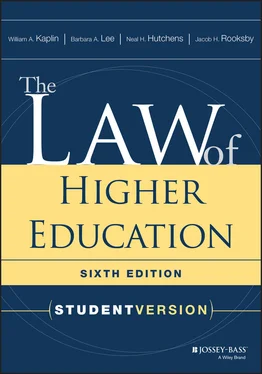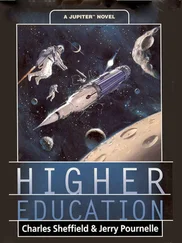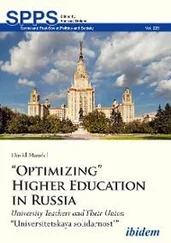The third approach, “public function,” focuses on the particular function being performed by the private entity. The Court has very narrowly defined the type of function that will give rise to a state action finding. It is not sufficient that the private entity provides services to the public, or that the services are considered essential, or that government also provides such services. Rather, according to the Jackson case (above), the function must be one that is “traditionally exclusively reserved to the State…[and] traditionally associated with sovereignty” (419 U.S. at 352–53) in order to support a state action finding.
In Rendell-Baker , the Court considered all three of these approaches, specifically finding that the high school's termination of the teachers did not constitute state action under any of the approaches. In its analysis, as set out above, the Court first rejected a nexus argument; then rejected a public function argument; and finally rejected a symbiotic relationship argument. The Court narrowly defined all three approaches, consistent with other cases it had decided since the early 1970s. Lower courts following Rendell-Baker and other cases in this line have continued to recognize the same three approaches, but only two of them—the nexus approach and the symbiotic relationship approach—have had meaningful application to postsecondary education. The other approach, public function, has essentially dropped out of the picture in light of the Court's sweeping declaration that education programs cannot meet the restrictive definition of public function in the Jackson case. 5 Various lower court cases subsequent to Rendell-Baker illustrate the application of the nexus and symbiotic relationship approaches to higher education, and also illustrate how Rendell-Baker , Blum v. Yaretsky ( Rendell-Baker 's companion case [see above]), and other Supreme Court cases such as Jackson v. Metropolitan Edison (see above) have served to insulate postsecondary institutions from state action findings and the resultant application of federal constitutional constraints to their activities. The following cases are instructive examples.
In Albert v. Carovano , 824 F.2d 1333, modified on rehearing , 839 F.2d 871 (2d Cir. 1987), panel opinion vacated , 851 F.2d 561 (2d Cir. 1988) ( en banc ), a federal appellate court, after protracted litigation, refused to extend the state action doctrine to the disciplinary actions of Hamilton College, a private institution. The suit was brought by students whom the college had disciplined under authority of its policy guide on freedom of expression and maintenance of public order. The college had promulgated this guide in compliance with the New York Education Law, Section 6450 (the Henderson Act), which requires colleges to adopt rules for maintaining public order on campus and file them with the state. The trial court dismissed the students' complaint on the grounds that they could not prove that the college's disciplinary action was state action. After an appellate court panel reversed, the full appellate court affirmed the pertinent part of the trial court's dismissal. The court ( en banc ) concluded:
[A]ppellants' theory of state action suffers from a fatal flaw. That theory assumes that either Section 6450 or the rules Hamilton filed pursuant to that statute constitute “a rule of conduct imposed by the state” [citing Lugar v. Edmondson Oil Co ., 457 U.S. 922, 937–39 (1982)]. Yet nothing in either the legislation or those rules required that these appellants be suspended for occupying Buttrick Hall. Moreover, it is undisputed that the state's role under the Henderson Act has been merely to keep on file rules submitted by colleges and universities. The state has never sought to compel schools to enforce these rules and has never even inquired about such enforcement [851 F.2d at 568].
Finding that the state had not undertaken to regulate the disciplinary policies of private colleges in the state, and that the administrators of Hamilton College did not believe that the Henderson Act required them to take particular disciplinary actions, the court refused to find state action.
In a decision involving a student sexual misconduct conduct proceeding, Doe v. University of Denver , 2018 WL 1304530 (D. Colo. March 13, 2018), the court considered whether a private university's enforcement of Title IX requirements sufficed to constitute state action. The plaintiff argued that the requirement that institutions must comply with Title IX standards as a condition of receiving federal funds made the university a state actor for purposes of the disciplinary hearing. The court concluded that such a rationale would prove “untenable” by potentially turning any private entity complying with a federal rule or law into a state actor. While the U.S. Court of Appeals for the Tenth Circuit had not provided guidance on whether Title IX compliance in a student disciplinary proceeding could constitute state action as to a private university, the court noted that other courts had ruled that it did not.
In an earlier case, Smith v. Duquesne University , 612 F. Supp. 72 (W.D. Pa. 1985), affirmed without opinion , 787 F.2d 583 (3d Cir. 1986), a graduate student challenged his expulsion on due process and equal protection grounds, asserting that Duquesne's action constituted state action. The court used both the symbiotic relationship and the nexus approaches to determine that Duquesne was not a state actor. Regarding the former, the court distinguished Duquesne's relationship with the state of Pennsylvania from that of Temple University and the University of Pittsburgh, which were determined to be state actors in Krynicky v. University of Pittsburgh and Schier v. Temple University , 742 F.2d 94 (3d Cir. 1984). There was no statutory relationship between the state and the university, the state did not review the university's expenditures, and the university was not required to submit the types of financial reports to the state that state-related institutions, such as Temple and Pitt, were required to submit. Thus the state's relationship with Duquesne was “so tenuous as to lead to no other conclusion but that Duquesne is a private institution and not a state actor” (612 F. Supp. at 77–78).
Regarding the latter approach (the nexus test), the court determined that the state could not “be deemed responsible for the specific act” complained of by the plaintiff. The court characterized the expulsion decision as “an academic judgment made by a purely private institution according to its official university policy” (612 F. Supp. At 78), a decision in which the government had played no part. (See also Urso v. Bradley University , 2018 WL 1547101 (C.D. Ill. March 29, 2018) [rejecting claims of state action by a nursing student, including the argument that the private university was a state actor because it received state funding].)
While Rendell-Baker and later lower court cases suggest that colleges will usually win state action cases, these cases do not create an impenetrable protective barrier for ostensibly private postsecondary institutions. In particular, there may be situations in which government is directly involved in some challenged activity—in contrast to the absence of government involvement in the actions challenged in Rendell-Baker and the lower court cases above. Such involvement may supply the “nexus” that was missing in these cases. In Doe v. Gonzaga University , 24 P.3d 390 (Wash. 2001), for example, the court upheld a jury verdict that a private university and its teacher certification specialist were engaged in action “under color of state law” (that is, state action) when completing state certification forms for students applying to be certified as teachers. The private institution and the state certification office, said the court, were cooperating in “joint action” regarding the certification process. 6 Moreover, there may be situations, unlike Rendell-Baker and the cases above, in which government officials by virtue of their offices sit on, or nominate others for, an institution's board of trustees. Such involvement, perhaps in combination with other “contacts” between the state and the institution, may create a “symbiotic relationship” that constitutes state action, as the court held in Krynicky v. University of Pittsburgh and Schier v. Temple University , above.
Читать дальше












